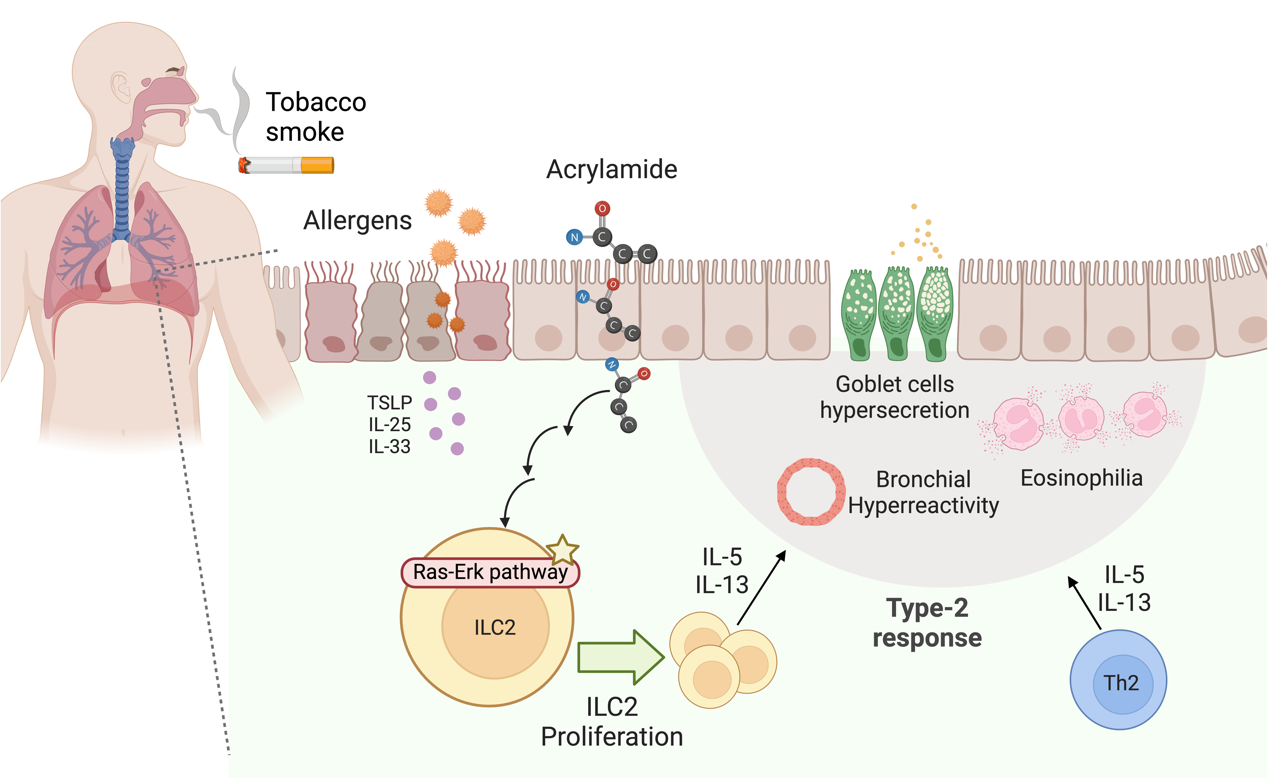Acrylamide, an air pollutant, enhances allergen-induced eosinophilic lung inflammation via group 2 innate lymphoid cells
2024 / 09 by Professor Jau-Ling Suen
What is Acrylamide?
Acrylamide is widely used in food processing, paper manufacturing, and wastewater treatment. In laboratories, it is also a key component in the Western blot technique. Naturally occurring acrylamide is present in many foods, primarily formed during baking and frying processes. This occurs when amino acids and reducing sugars in the food undergo the "Maillard reaction" at high temperatures, leading to the formation of acrylamide. Additionally, acrylamide is also present in the air, with particularly high concentrations found in cigarette smoke.
How does Acrylamide affect us?
Acrylamide can enter the body through skin contact, food, and by inhalation as an air pollutant. Inhalation of acrylamide is known to have neurotoxic effects on humans. Although epidemiological data have not yet confirmed the carcinogenicity of acrylamide in humans, there is significant evidence linking acrylamide exposure to allergic symptoms. However, the impact of inhaled acrylamide on the human immune system remains unknown.
What is Eosinophilic lung inflammation?
Eosinophils play a crucial role in the body’s defense against parasites and in allergic reactions. However, when eosinophils become overactive and infiltrate tissues, releasing inflammatory substances, they can cause an inflammatory response. One of the cytokines that induces eosinophil infiltration is Interleukin-5 (IL-5), which is mainly secreted by T helper 2 (Th2) cells and Group 2 innate lymphoid cell (ILC2). Eosinophilic lung inflammation is common among asthma patients. When these patients are exposed to allergens (such as mold, pollen, or animal dander), an overreaction of the immune system causes lung inflammation and bronchial hyperresponsiveness, leading to symptoms like difficulty in breathing.
What is the purpose of this study?
This study aims to investigate the immunological effects and mechanisms of inhaled acrylamide on lung inflammation in the context of allergic lung inflammation.
What did we discover?
The study found that mice exposed to low doses of acrylamide via nasal inhalation exacerbated eosinophilic lung inflammation induced by allergens, with increased eosinophil infiltration. The mechanism is primarily through acrylamide-enhanced proliferation of ILC2 cells. The same phenomenon was observed in mice lacking T and B cells (Rag1-/- mice), and a significant increase in eosinophils in bronchoalveolar lavage fluid was also noted after adoptive transfer of acrylamide-treated ILC2 cells, indicating the crucial role of ILC2 in the acrylamide response.
What does the increased lung inflammation due to inhaled acrylamide tell us?
This study confirms that acrylamide in the air may pose additional health risks for individuals with allergic diseases, particularly those with allergic asthma. This study not only reminds us to pay greater attention to the potential impact of environmental air pollutants, but also provides new insights for future treatments of allergic diseases.
Graphical Abstract:

Application and Highlights:
1) Low-dose acrylamide, an air pollutant, exposure promotes eosinophilic inflammation.
2) Acrylamide directly enhances lung ILC2 proliferative activity.
3) Acrylamide induces proliferation of ILC2s through the Ras-Erk pathway.
More Information:
Su HH, Cheng CM, Yang YN, Chang YW, Li CY, Wu ST, Lin CC, Wu HE, Suen JL*. Acrylamide, an air pollutant, enhances allergen-induced eosinophilic lung inflammation via group 2 innate lymphoid cells. Mucosal Immunol. 2024 Feb;17(1):13-24. doi: 10.1016/j.mucimm.2023.09.007.(SCIE, IF2023: 7.9, 21/181=11.60% in IMUNOLOGY)
Research Team Members:
Prof. Jau-Ling Suen, Tzu-Hsuan Wong, PhD, Hsiang-Han Su, PhD.
Introduction of Research Team:
Professor Suen's team has long been dedicated to studying the harmful effects of chronic exposure to environmental pollutants on the immune system, hoping that these research findings can be applied to prevent the worsening of asthma or to develop new therapies.

